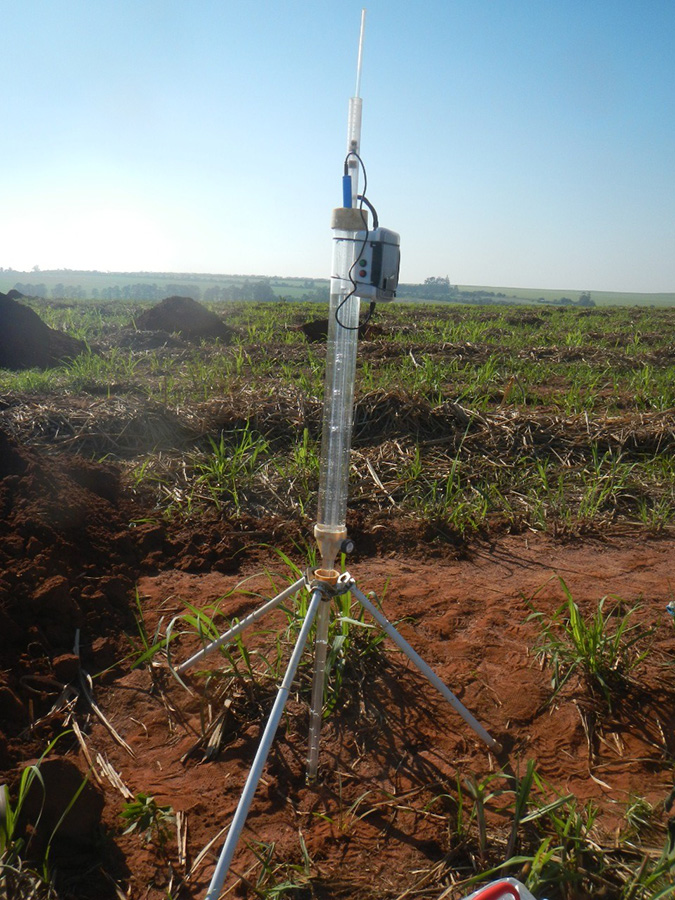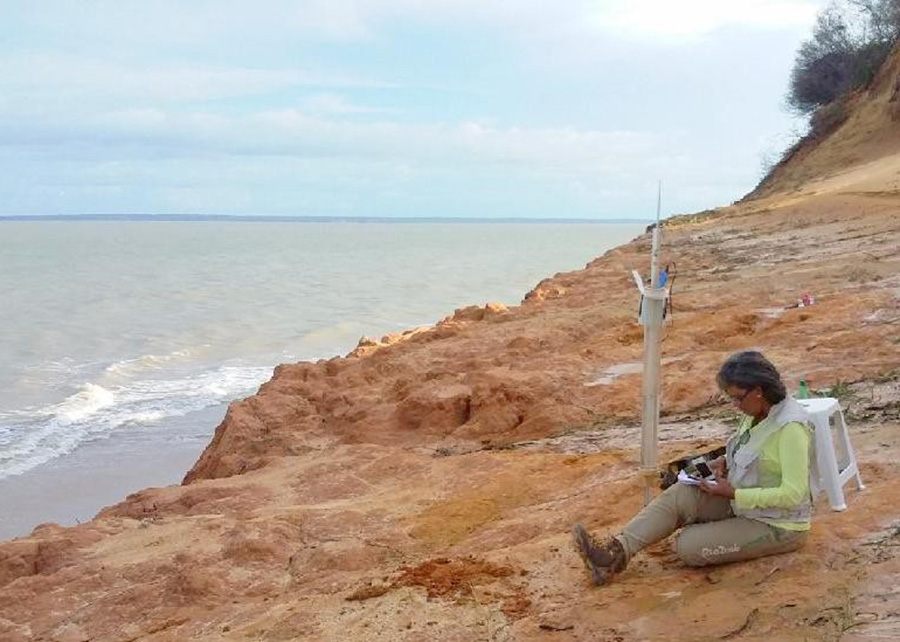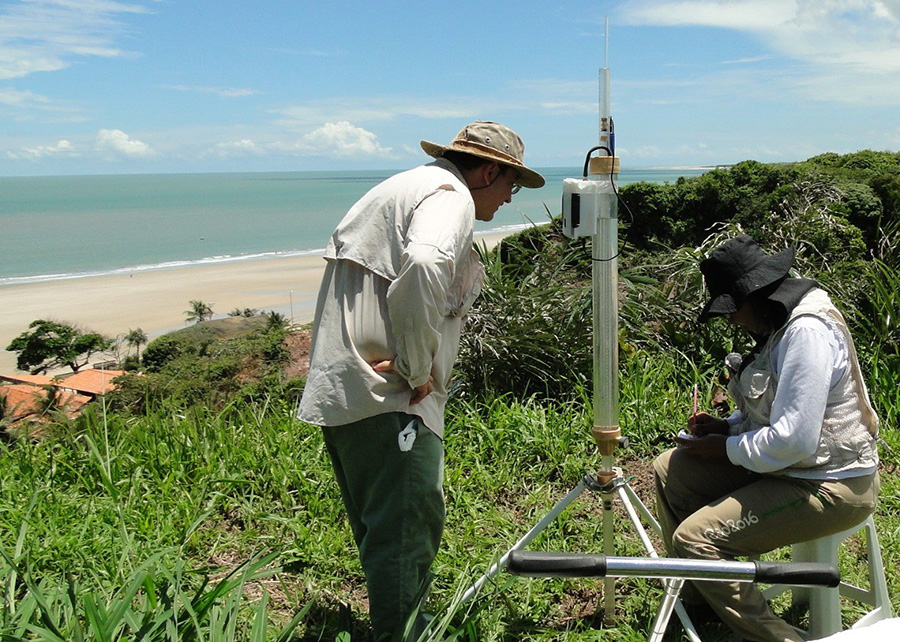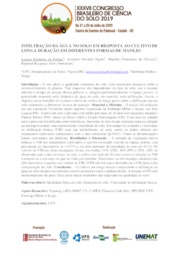An innovative equipment can digitally measure the water that has been absorbed by the soil. The technology reduces the time and cost of the process as data collection no longer depends on a trained technician. Measuring the water that has infiltrated into the soil is fundamental for irrigation and to build roads and dams, for instance. The new digital permeameter is the result of a partnership between Embrapa and the Brazilian Center for Research in Physics (CBPF). The equipment is ready and awaits a partner to produce it on a large scale for the market. The partner institutions already aim at other challenges related to agriculture 4.0. A partnership between Embrapa Soils and the Brazilian Center for Research in Physics (CBPF) - both of which are based in Rio de Janeiro, RJ -, developed an innovative solution for the automation of field data collection, more specifically on water infiltration and flow in the soil. It is a new permeameter - the equipment most commonly used in the world to assess water conduction in the soil - that can digitally make such collection through a low-cost microcomputer. With that, it reduces the time and the costs of the assessment of hydraulic parameters, which provides knowledge on the process of water absorption by the earth. The institutions now seek a partner to produce the equipment on a large scale and insert it in the market. Measuring the amount of water infiltrated in the soil is fundamental not only to optimize irrigation, reducing water waste and erosion; but also to estimate landslides in hillsides, helping in their prevention and elaboration of more efficient alarms and in the assessment of the behavior of lands to build roads or dams. However, assessing soil hydraulic parameters has always been a challenge for researchers, basically for two reasons: the need for a technician to be trained in data collection and assessment, which takes a long time and many funds. Thus, one of the advantages of addressing the problem in an interdisciplinary way was to combine the expertise and experience of those who understands of soil problems (Embrapa Soils) with the application of smart sensors, digital control tools and signal conditioning (CBPF). The new permeameter: digitalization of soil water measurements The equipment that is most commonly used in the world to assess water conduction in saturated soils is well permeameters, one of the most popular of which is the Guelph Permeameter. It requires a professional to manually collect data on water flows, which enables the estimation of the soil hydraulic conductivity. “The partnership between Embrapa and CBPF developed a new permeameter that automates such collection. With this device, the technician, who would once spend hours writing down the values for the flows, is then spared to make other assessments and collections, thus increasing labour efficiency in agriculture. Moreover, the equipment has a reading accuracy of millimeters and a time record in tenths of second, which increases the precision of the collected data”, reports the Embrapa Soil researcher Wenceslau Teixeira. The Guelph is an analogical equipment of complex operation. The data are obtained through the visual reading of the variation of the level of a water column, using a millimetered scale and a chronometer. The data are then manually recorded in a passbook. This operation is performed in the field, under the sun, and can take a long time. The operator is an expensive professional who needs to be trained on measurement data acquisition, and the results are later analyzed using spreadsheets. The progress posed by the new device lies in the fact that the measures are obtained digitally, by a low-cost microcomputer. “In addition to more accurately measuring variations in volume and time, recording them onto a memory card and broadcasting such data to a cell phone or tablet (via Bluetooth), the system calculates the figures immediately. If there is any inconsistency in the measurements, it is possible to identify it on the spot and remake them, dispensing with a new and costly displacement. The device simplifies the measurement operation, allowing its use by operators with less training, and warns them against certain errors due to sudden variations in temperature that would not be considered in traditional methods”, explains Geraldo Cernicchiaro, from CBPF. One should recall that CBPF has large experience in creating measurement sensors, especially ones that are not available in the market yet. An innovative approach The challenge of digitalizing this process was precisely the identification of how to automate the data collection. The Guelph methodology is based on digging a small well in the soil and vertically overturning a long closed transparent polyurethane cylinder with water inside. The water tends to flow from the tube, due to gravity, and fill the well until the level covers the top of the tube. This causes some vacuum within the tube, whose technical name is Mariotte's bottle. At a certain point the atmospheric pressure becomes equivalent to the one resulting from the height of the water column and the vacuum within the bottle, and thus the water stops flowing. As the water penetrates into the soil, the water level in the well is changed. Small air bubbles enter the reservoir modifying the pressure, and the liquid goes down. Until balance is restored. In the manual method, a millimetered scale helps to determine the variation in the water level and the subsequent volume. “Our approach was to include a tool to measure pressure and temperature, with the precision required to monitor the variation of the vacuum in Mariotte's bottle. This approach made the automation of the process possible, and our field and laboratory tests demonstrated its accuracy. Once the data is digitalized, we have access to a vast range of technological resources. A small microcontroller receives such information, an internal clock records the variations between the measures and the time of reading, and a program allows us to process, calculate, record and present the result in a display”, states Cernicchiaro, detailing the process. Field tests make scientists enthusiastic After some tests with prototypes at CBPF's and Embrapa's laboratories and lands, the device was validated through a field project in two locations: São Luís, MA, and Lençóis Paulista, SP. “The results were excellent, which motivated us to publish them in a paper on the Journal of Hydrology reporting this achievement”, Teixeira underscores. The places were chosen because they have different types of soil, which has an impact on water absorption. For instance, in sandy soils, it is quickly absorbed. Meanwhile in clay soils the absorption is slower, and can even form puddles. In a simple terms, this means that different soils present diverse behaviors regarding the process of absorbing the liquid, and that such behaviors can be quantified. One of the parameters associated with this behavior is saturated hydraulic conductivity. This parameter, which characterizes each kind of soil, is the ratio between the volume of water absorbed per unit of time, when the soil is wet or, in technical terms, saturated. New challenges for the partnership The Embrapa/CBPF partnership is also involved in other challenges, like the development of automated sensors to measure potential water in the soil, and automated data collection in infiltrometers and evaporation tanks.
Photo: Embrapa Soils

The equipment favors the assessment of soil hydraulic parameters, which has always was been a challenge for researchers
-
An innovative equipment can digitally measure the water that has been absorbed by the soil. -
The technology reduces the time and cost of the process as data collection no longer depends on a trained technician. -
Measuring the water that has infiltrated into the soil is fundamental for irrigation and to build roads and dams, for instance. -
The new digital permeameter is the result of a partnership between Embrapa and the Brazilian Center for Research in Physics (CBPF). -
The equipment is ready and awaits a partner to produce it on a large scale for the market. -
The partner institutions already aim at other challenges related to agriculture 4.0. |
A partnership between Embrapa Soils and the Brazilian Center for Research in Physics (CBPF) - both of which are based in Rio de Janeiro, RJ -, developed an innovative solution for the automation of field data collection, more specifically on water infiltration and flow in the soil. It is a new permeameter - the equipment most commonly used in the world to assess water conduction in the soil - that can digitally make such collection through a low-cost microcomputer. With that, it reduces the time and the costs of the assessment of hydraulic parameters, which provides knowledge on the process of water absorption by the earth. The institutions now seek a partner to produce the equipment on a large scale and insert it in the market.
Measuring the amount of water infiltrated in the soil is fundamental not only to optimize irrigation, reducing water waste and erosion; but also to estimate landslides in hillsides, helping in their prevention and elaboration of more efficient alarms and in the assessment of the behavior of lands to build roads or dams.
However, assessing soil hydraulic parameters has always been a challenge for researchers, basically for two reasons: the need for a technician to be trained in data collection and assessment, which takes a long time and many funds. Thus, one of the advantages of addressing the problem in an interdisciplinary way was to combine the expertise and experience of those who understands of soil problems (Embrapa Soils) with the application of smart sensors, digital control tools and signal conditioning (CBPF).
 The new permeameter: digitalization of soil water measurements The new permeameter: digitalization of soil water measurements
The equipment that is most commonly used in the world to assess water conduction in saturated soils is well permeameters, one of the most popular of which is the Guelph Permeameter. It requires a professional to manually collect data on water flows, which enables the estimation of the soil hydraulic conductivity. “The partnership between Embrapa and CBPF developed a new permeameter that automates such collection. With this device, the technician, who would once spend hours writing down the values for the flows, is then spared to make other assessments and collections, thus increasing labour efficiency in agriculture. Moreover, the equipment has a reading accuracy of millimeters and a time record in tenths of second, which increases the precision of the collected data”, reports the Embrapa Soil researcher Wenceslau Teixeira. The Guelph is an analogical equipment of complex operation. The data are obtained through the visual reading of the variation of the level of a water column, using a millimetered scale and a chronometer. The data are then manually recorded in a passbook. This operation is performed in the field, under the sun, and can take a long time. The operator is an expensive professional who needs to be trained on measurement data acquisition, and the results are later analyzed using spreadsheets. The progress posed by the new device lies in the fact that the measures are obtained digitally, by a low-cost microcomputer. “In addition to more accurately measuring variations in volume and time, recording them onto a memory card and broadcasting such data to a cell phone or tablet (via Bluetooth), the system calculates the figures immediately. If there is any inconsistency in the measurements, it is possible to identify it on the spot and remake them, dispensing with a new and costly displacement. The device simplifies the measurement operation, allowing its use by operators with less training, and warns them against certain errors due to sudden variations in temperature that would not be considered in traditional methods”, explains Geraldo Cernicchiaro, from CBPF. One should recall that CBPF has large experience in creating measurement sensors, especially ones that are not available in the market yet. |

An innovative approach
The challenge of digitalizing this process was precisely the identification of how to automate the data collection. The Guelph methodology is based on digging a small well in the soil and vertically overturning a long closed transparent polyurethane cylinder with water inside. The water tends to flow from the tube, due to gravity, and fill the well until the level covers the top of the tube. This causes some vacuum within the tube, whose technical name is Mariotte's bottle. At a certain point the atmospheric pressure becomes equivalent to the one resulting from the height of the water column and the vacuum within the bottle, and thus the water stops flowing. As the water penetrates into the soil, the water level in the well is changed. Small air bubbles enter the reservoir modifying the pressure, and the liquid goes down. Until balance is restored. In the manual method, a millimetered scale helps to determine the variation in the water level and the subsequent volume.
“Our approach was to include a tool to measure pressure and temperature, with the precision required to monitor the variation of the vacuum in Mariotte's bottle. This approach made the automation of the process possible, and our field and laboratory tests demonstrated its accuracy. Once the data is digitalized, we have access to a vast range of technological resources. A small microcontroller receives such information, an internal clock records the variations between the measures and the time of reading, and a program allows us to process, calculate, record and present the result in a display”, states Cernicchiaro, detailing the process.
 Field tests make scientists enthusiastic Field tests make scientists enthusiastic
After some tests with prototypes at CBPF's and Embrapa's laboratories and lands, the device was validated through a field project in two locations: São Luís, MA, and Lençóis Paulista, SP. “The results were excellent, which motivated us to publish them in a paper on the Journal of Hydrology reporting this achievement”, Teixeira underscores. The places were chosen because they have different types of soil, which has an impact on water absorption. For instance, in sandy soils, it is quickly absorbed. Meanwhile in clay soils the absorption is slower, and can even form puddles. In a simple terms, this means that different soils present diverse behaviors regarding the process of absorbing the liquid, and that such behaviors can be quantified. One of the parameters associated with this behavior is saturated hydraulic conductivity. This parameter, which characterizes each kind of soil, is the ratio between the volume of water absorbed per unit of time, when the soil is wet or, in technical terms, saturated. |
New challenges for the partnership
The Embrapa/CBPF partnership is also involved in other challenges, like the development of automated sensors to measure potential water in the soil, and automated data collection in infiltrometers and evaporation tanks.
Carlos Dias (MTb 20.395/RJ)
Embrapa Soils
Press inquiries
solos.imprensa@embrapa.br
Phone number: +55 21 2179-4578
Mariana Medeiros (Translation - English)
General Secretariat
Further information on the topic
Citizen Attention Service (SAC)
www.embrapa.br/contact-us/sac/


